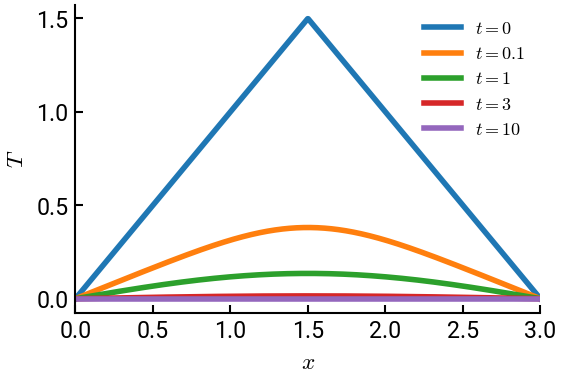8. 1D heat conduction equation#
Modeling heat conduction is a ubiquitous task in engineering, and one main approach is to use the diffusion equation (of which the heat equation is a special case, for constant diffusivity), a second-order partial differential equation. Here we will showcase an example in 1 dimension, where \(x\) is the only position variable.
Summary of commands#
In this exercise, we will demonstrate the following:
Masking of indices. That is, if
x = [1, 3, 5, 4, 2], thenx > 2produces the Boolean array[False, True, True, True, False]. It is useful for indexing into NumPy arrays based on certain conditions for other arrays.
Demo#
The temperature of the ends of a rod with length \(3\) is heated such that
The ends of the rod are then connected to insulators to maintain the ends at \(T(0,t) = 0\) and \(T(3,t)=0\). The solution to the heat conduction equation \(\lambda \dfrac{\partial^2 T}{\partial x^2} = \dfrac{\partial T}{\partial t}\) with \(\lambda=1\), is:
Plot the temperature distribution of the rod at \(t = 0\), \(0.1\), \(1\), \(3\), and \(10\).
# import libraries
import numpy as np
import matplotlib.pyplot as plt
# constants
nmax = 11
x = np.linspace(0, 3, 1000)
ts = [0, 0.1, 1, 3, 10]
fig, ax = plt.subplots()
for t in ts:
T = np.zeros(x.shape)
if t == 0: # initial condition
T[x < 3/2] = x[x < 3/2]
T[x > 3/2] = 3 - x[x > 3/2]
else: # all other cases - Note the two loops!
for n in np.arange(1, nmax, 4):
Bn = 4 / (n**2 * np.pi**2)
T += Bn * np.sin(n * np.pi * x / 3) * np.exp(-n**2 * np.pi**2 / 9 * t)
for n in np.arange(3, nmax, 4):
Bn = -4 / (n**2 * np.pi**2)
T += Bn * np.sin(n * np.pi * x / 3) * np.exp(-n**2 * np.pi**2 / 9 * t)
ax.plot(x, T, label=f"$t={t}$")
ax.set(xlabel='$x$', ylabel='$T$', xlim=[0,3])
ax.legend(fontsize=13)
plt.show()


